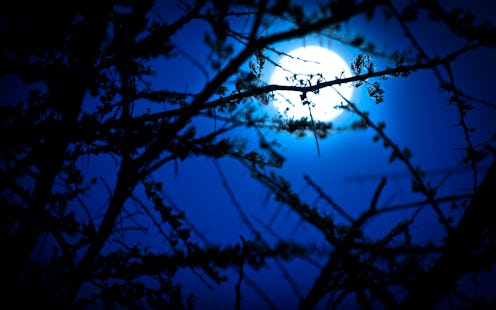Life
November’s Full Moon Is Going To Bring Some Big Astrological Changes

You're probably already pretty familiar with the Harvest Moon (thanks, Neil Young), which is the common name for the full moon that falls closest to the autumn equinox. It last lit up the sky on Oct. 5, 2017 — and since an October appearance of this lunar event is actually pretty rare, the Harvest Moon got a lot of attention earlier this fall. Other full moons are just as significant, though — and just because they haven't been immortalized in song doesn't mean we should forget about them! Take, for example, Nov. 2017's full moon, the Frost Moon, which will make an appearance on Nov. 4. Similar to the Harvest Moon, it has a lot of astrological impact — so you may be wondering, is the Frost Moon rare, or at least as rare as an Oct. Harvest Moon was?
Well, first, it's worth knowing a little bit about the Frost Moon — even if you're not an astronomy or astrology buff — because its appearance is your signal that winter is coming (and not in a Game of Thrones kind of way).
According to Almanac.com, November's full moon — which is nicknamed the Frost Moon, the Mourning Moon, or the Beaver Moon, depending on where you are — will crest on Nov. 4 just after 1 a.m. EST. The moon will look fullest and brightest earlier that night (on Nov. 3). Per Almanac.com, the Frost Moon was so named by Native American communities because of its timing: Simply put, this particular full moon typically takes place at roughly the same time as the first frost. If you were debating whether or not to take out your winter coats, you may want to go ahead and do it — at least, you should if you put any stock in the lunar calendar! Even if you don't, you've gotta admit that nature seems to be getting it right this time. 'Tis the season for temperatures to drop, and many regions can expect to get their first frost in the next few weeks, if they haven't already.
American colonists and Algonquin tribes also referred to the November full moon as the Beaver Moon. When they saw it in the sky, they knew that the water was about to freeze, so they would hurry to set beaver traps before they missed out on the opportunity to collect a supply of warm winter furs. The full moon was an indicator of the changing seasons and made it easier for people to prepare themselves for what was to come.
The 2017 Frost Moon should be pretty close to the Moon's perigee — or its closest point to Earth during the monthly orbit — which is causing some buzz about a "supermoon," Almanac.com says. While this full moon is almost a supermoon, we'll actually have to wait one more month for that particular phenomenon. A supermoon occurs when the moon is at or within 90 percent of its closest approach to Earth in its orbit. In 2017, that will happen in December — so keep your eyes to the sky for that! The December full moon will be visible on Dec. 3, and thanks to its proximity to us, it should be a pretty spectacular sight.
In the meantime, though, we can be grateful for the Frost Moon and the way it played an important role in the lives of our ancestors. Without having it as a reminder of the winter that was to come, they may have missed the opportunity to prepare for the cold temperatures ahead of time, and where would that have left them — or us? Probably nowhere, if I'm being real. So while I'm not readying to set out any beaver traps this year, I'll look forward to my glimpse of the Frost Moon on Nov. 3. And you can bet I'll break out my hat and gloves for the occasion.
Images: Stefano Oppo/Photodisc/Getty Images; Giphy